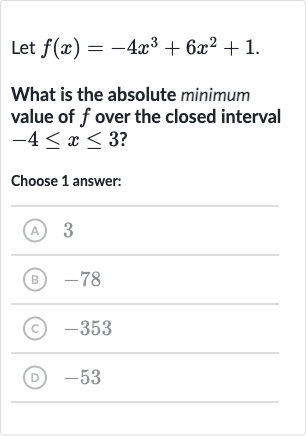Full solution
Q. Let .What is the absolute minimum value of over the closed interval ?Choose answer:(A) (B) (C) (D)
- Find Derivative: To find the absolute minimum value of the function on the closed interval, we need to find the critical points of the function within the interval and evaluate the function at the endpoints of the interval.
- Locate Critical Points: First, we find the derivative of the function to locate the critical points. The derivative is given by:.
- Evaluate Function: Next, we set the derivative equal to zero to find the critical points: or .
- Calculate Absolute Minimum: Now we evaluate the function at the critical points and at the endpoints of the interval: , , , and .
- Calculate Absolute Minimum: Now we evaluate the function at the critical points and at the endpoints of the interval: , , , and .Evaluating at : .
- Calculate Absolute Minimum: Now we evaluate the function at the critical points and at the endpoints of the interval: , , , and .Evaluating at : .Evaluating at : .
- Calculate Absolute Minimum: Now we evaluate the function at the critical points and at the endpoints of the interval: , , , and .Evaluating at : .Evaluating at : .Evaluating at : .
- Calculate Absolute Minimum: Now we evaluate the function at the critical points and at the endpoints of the interval: , , , and .Evaluating at : .Evaluating at : .Evaluating at : .Evaluating at : .
- Calculate Absolute Minimum: Now we evaluate the function at the critical points and at the endpoints of the interval: , , , and .Evaluating at : .Evaluating at : .Evaluating at : .Evaluating at : .Comparing the values of at the critical points and endpoints, we find that the smallest value is . However, since we are looking for the absolute minimum, we need to consider the negative of this value, which is .
- Calculate Absolute Minimum: Now we evaluate the function at the critical points and at the endpoints of the interval: , , , and . Evaluating at : . Evaluating at : . Evaluating at : . Evaluating at : . Comparing the values of at the critical points and endpoints, we find that the smallest value is . However, since we are looking for the absolute minimum, we need to consider the negative of this value, which is . The absolute minimum value of the function over the closed interval is .
More problems from Euler's method
QuestionGet tutor help
QuestionGet tutor help
QuestionGet tutor help
QuestionGet tutor help
QuestionGet tutor help
QuestionGet tutor help
QuestionGet tutor help
QuestionGet tutor help
QuestionGet tutor help

